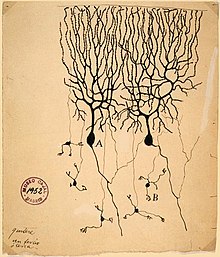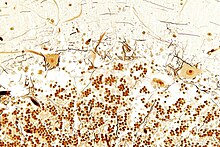Granule cell

Granular cell or granular cell ( Neuronum granuliforme ) describes a morphological type of small nerve cells with a spherical perikaryon , to which numerous interneurons from different brain regions belong.
Granule cells are particularly dense in the cortex of the cerebrum and cerebellum. In the endbrain they are found especially neocortically in layer IV ( stratum granulosum internum ) of the isocortex of the cerebral cortex , archicortically in the hippocampus and paleocortically in the olfactory bulb . Most of the granule cells, however, are located in the cerebellum , in the stratum granulosum of the cerebellar cortex.
Granule cells in the cortex of the cerebrum
The granule cells of the cerebral cortex appear as inhibitory ( inhibitory ) or excitatory ( excitatory ) interneurons; those with a spherically branched dendrite tree are also known as stellate cells . Mostly they are multipolar neurons with an apolar orientation, which, in contrast to pyramidal cells, are not oriented towards the brain surface. Their cell body is about 10 µm in size and therefore significantly smaller than that of pyramidal cells. In contrast to these, they only have relatively short axons that make contacts with neurons in the vicinity, other interneurons or neighboring pyramidal cells. The dendrites of certain granule cells can have fine postsynaptic protuberances, so-called thorny processes that look like thorns , especially those of locally exciting granule cells or stellate cells. However, the majority of granule cells in the cerebral cortex are thornless inhibitory ( GABA -ergic) interneurons.
In the six-layer isocortex , these neurons are found in the inner granular layer called lamina IV. This layer is particularly pronounced in those cortical regions that are reached by sensory or sensory projections from specific nuclei of the thalamus . These include, for example, areas of the cerebral cortex, which are also known as the primary somatosensory cortex , visual cortex (visual cortex) or auditory cortex (auditory cortex).
Granule cells in the hippocampus
The dentate gyrus of the hippocampal formation receives cortical afferents via its molecular layer ( stratum molecularulare ) and connects them to the granular cell layer ( stratum granulare ). Its main cells are excitatory, glutamatergic granule cells, the dendrites of which branch out in the molecular layer. In addition to these excitatory granule cells, there are also a number of different inhibitory, GABAergic interneurons.
Granule cells in the olfactory bulb
The granule cells in the olfactory bulb ( bulbus olfactorius ) work with GABA as a neurotransmitter and thus form inhibitory synapses . Your dendrites receive excitatory signals from the axon collaterals of the mitral cells and also from their dendrites. Inhibiting influences are mediated via retrograde centrifugal axons from secondary olfactory areas of the olfactory brain .
These granule cells are characterized by a bipolar and thorny dendritic system; they do not have an actual axon. While the dorsal dendritic tree makes axodendritic contacts, the dendritic branches of the ventral pole make dendrodendritic contacts with mitral cells. A special feature of this is reciprocal synapses , in which, in addition to the inhibitory one from the granule cell dendrite to the mitral cell dendrite, a synaptic connection with an excitatory effect on the dendritic region of the granule cell is formed by the mitral cell dendrite.
Granule cells in the cortex of the cerebellum

In the picture above, surrounded by glia, the processes and large cell bodies of a few Purkinje cells in close contact with some black-stained processes of basket cells are stained light brown .
These include the location of the cerebellar granule cells , which in mammals make up over 50% of all neurons.
The granule cells in the cortex of the cerebellum represent the largest number of all neurons in the mammalian brain. In humans, over 50% of all nerve cells are granule cells in the cerebellum. They lie in the so-called granular cell layer ( stratum granulosum ) of the cerebellar cortex . Each of these cells has four short unbranched dendrites and each sends an axon into the molecular layer of the cerebellar cortex. There the axons of the granule cells branch out and form what are known as parallel fibers. These have an exciting effect on Purkinje cells via glutamatergic synapses .
In vivo , cerebellar granule cells fire at a low frequency (0.2-0.5 Hz). Signals of afferent neurons of the brain stemgeneratedby sensory stimulation, for example by whiskers , which are transmittedvia the moss fibers into the granular layer of the cerebellum, post-synaptic granular cells can be stimulated to fire "packets" of action potentials ("bursts"). Series with low EPSP currents are sufficient for this, while individual spontaneously formed signals from moss fibers can only do this with reduced inhibition. Granule cells in the cerebellar cortex combine high sensitivity with a good signal-to-noise ratio .
Individual evidence
- ↑ a b c Benninghoff: Macroscopic and microscopic anatomy of humans, Vol. 3. Nervous system, skin and sensory organs . Urban and Schwarzenberg, Munich 1985, ISBN 3-541-00264-6 , p. 301 and p. 373 and p. 559.
- ^ Paul Chadderton, Troy W. Margrie, Michael Häusser: Integration of quanta in cerebellar granule cells during sensory processing. In: Nature. 428, 2004, p. 856, doi : 10.1038 / nature02442 .